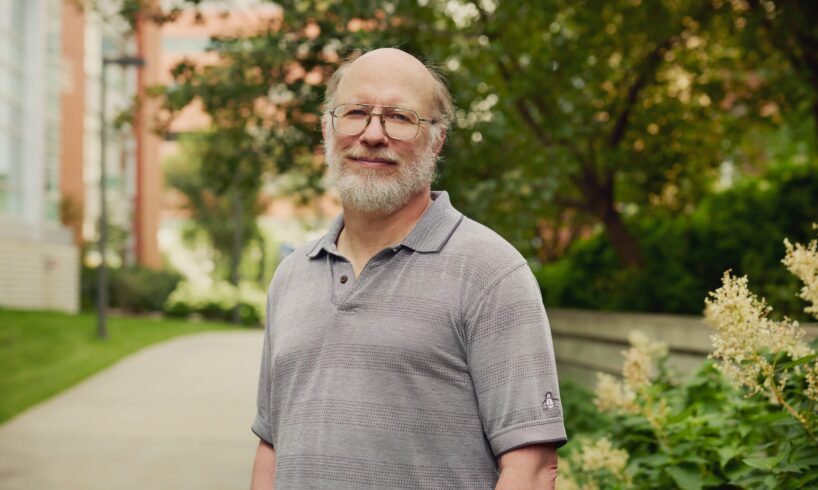
Open this photo in gallery:
Dr. David Wishart was named this year’s recipient of the Gerhard Herzberg Canada Gold Medal for Science and Engineering for his role in helping to build metabolomics from the ground up.Sylvie Li/Supplied
If human beings were cereal boxes, David Wishart would be writing the ingredients labels.
As it turns out, those ingredients are many, with many more that remain unknown. And unlike cereal boxes, the list changes over time in ways that offer clues to health, disease, environmental exposures and more.
Such is the domain of metabolomics, a big-picture science that deals with the smallest molecules moving through us and connecting us to the wider world.
On Thursday, Dr. Wishart was named this year’s recipient of the Gerhard Herzberg Canada Gold Medal for Science and Engineering, the country’s most prestigious award for researchers in those fields, specifically for his role in helping to build metabolomics from the ground up.
“I’m curious about a lot of things,” said Dr. Wishart, a distinguished professor both in biological and computing science at the University of Alberta. “I’ve sort of fallen into a realm where I end up making connections from the small to the big – from small molecules to big molecules to organisms – trying to understand it all.”
Born in Edmonton to a Métis family with roots in rural Alberta, Dr. Wishart grew up steeped in science and curiosity about the living world.
“My dad was a wildlife biologist and my mom a naturalist, so we always had this interest,” he said.
Open this photo in gallery:
Metabolomics is a big-picture science that deals with the smallest molecules moving through us and connecting us to the wider world.Sylvie Li/Supplied
With the Alberta badlands as his backyard, it was also a world where a boy keen on dinosaurs could search for real fossils – which Dr. Wishart did with enthusiasm, counting the toe bone of a duck-billed dinosaur among his childhood discoveries.
But growing up he was aware that some of the biggest names in the history of science, such as Newton and Einstein, were physicists. So when it came time to choose a university major, Dr. Wishart set his sights on a physics degree at the University of Alberta. This would ultimately provide a crucial foundation, because it exposed him to principles and technologies that are essential for exploring the molecular world.
Dr. Wishart then went on to do graduate work at Yale University, where he earned his PhD in molecular biophysics and biochemistry in 1991. It was a period that exposed him to a number of colleagues, including future Nobel Prize winners who were passionately chasing research problems with the emerging tool kit of molecular biology. For Dr. Wishart, that included exploring protein structure with a technique called nuclear magnetic resonance.
Several career directions were possible in the United States, but for Dr. Wishart the most appealing option brought him back to Alberta, where research connections and the Canadian funding environment suited the kind of exploratory science he hoped to pursue.
By the end of the 1990s the Human Genome Project had researchers thinking about the potential of molecular data on the largest scale, encompassing entire swaths of biology. It was around then that a new term was introduced into the biomedical lexicon: metabolomics – the study of all the smaller molecules that make up a biological system, such as the human body, and that interact with it in a myriad of ways.
“The perspective then was we’ve got DNA, we’ve got proteins, and then there’s this other stuff, called metabolites, that we tend to forget about and that need to be part of the conversation,” Dr. Wishart said.
But just like genomics, metabolomics requires its own digital infrastructure in order for researchers to make progress, such as libraries of identified molecules and ways to exchange information about them. Addressing that gap appealed to Dr. Wishart’s wide-ranging interests.
As one of the first scientists to enter the field, he would ultimately play a key role in its development, including the creation of the Human Metabolome Database. Launched in 2007, it currently holds information on more than 200,000 molecules found in the body. It now includes additional databases for drugs, environmental toxins and food additives, and has been accessed by researchers in some 190 countries.
Open this photo in gallery:
Dr. Wishart has played a key role in the development of metabolomics, including the creation of the Human Metabolome Database.Sylvie Li/Supplied
“I remember when I was a postdoc over 20 years ago, writing my first grants and citing that work as a resource that I could use,” said Thomas Metz, a past president of the Metabolomics Association of North America and a researcher based in Washington State.
Dr. Metz added that Dr. Wishart has been a continuing presence in the field, known for his own research but also for creating tools and software that support others. This has frequently taken him around the globe to work with other groups and labs developing their own metabolomics programs.
Rafa Montenegro Burke, who leads a metabolomics research group based at the University of Toronto, said he rarely makes it through a week without consulting a resource that Dr. Wishart had a hand in.
As he reflected on receiving the Herzberg medal, Dr. Wishart said he has always favoured an open approach to science, sharing ideas, technologies and methods to move knowledge forward.
“It grows the field and that way we’re all better off,” he said.
Dr. Wishart will receive his award at a special ceremony in Ottawa on Nov. 5.
Named for one of the country’s past Nobel laureates, the Gerhard Herzberg gold medal is bestowed annually by the Natural Sciences and Engineering Research Council of Canada, which distributes federal funding to university-based researchers.
The medal comes with a grant of up to $1-million over a five-year period to support personal university-based research or related initiatives, such as scholarships or research chairs at Canadian universities.
Other awards announced by the research council Thursday include the Polanyi Prize, which goes to Jeremy Quastel, a mathematician at the University of Toronto, and the Donna Strickland Prize for Societal Impact, won by University of Guelph hydrologist Beth Parker and University of Ottawa physicist Xiaoyi Bao. Several additional winners of innovation awards and research fellowships were also named.





